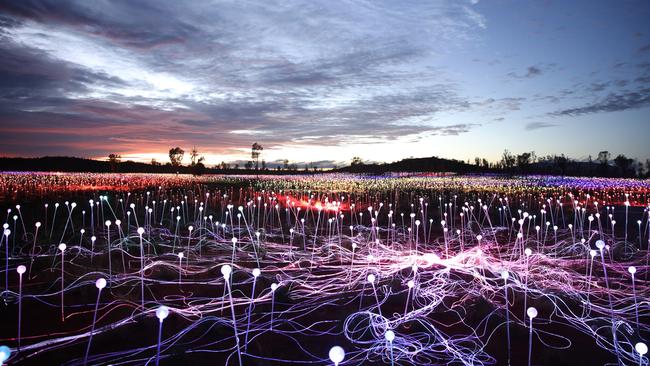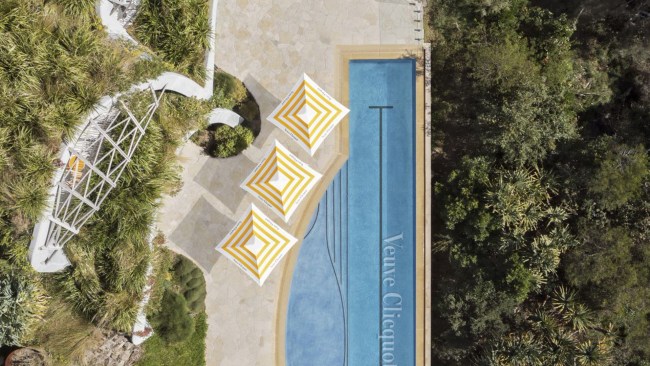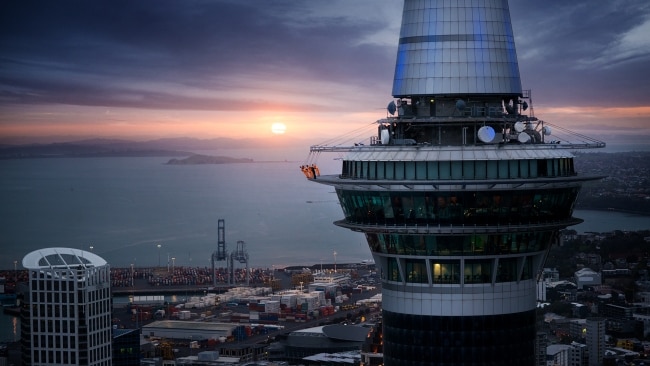Uluru light years ahead
A new attraction has taken centre stage at Uluru.

Take one massive sandstone monolith, so powerfully magnificent in its isolation that you become overwhelmed in its presence. Then, in front, plant 50,000 long-stemmed lights in an enormous expanse of red sand covering the size of four football fields.
Bruce Munro spent 24 years wondering how best to show his appreciation for the awe he experienced when he first saw Uluru in 1992, and the inspiration that led him to become a leading immersive installation artist. “[Ayers Rock] seemed to have this presence and energy coming out of the ground and I had never felt so alive,” he says of the love at first sight he experienced in the Red Centre, a shock to his sense of cynicism. He was on a trip marking the end of eight years living in Australia and had no thoughts of improving on nature when he envisaged planting a sea of illuminated stems near the rock, creating “an artwork that would bloom at night, like dormant desert seeds responding to rain”.
Last week Munro’s dream was realised when Field of Light Uluru, a magnificent display of colour and light set against the majesty of Ayers Rock, opened as a personal paean to one man’s gratitude that has, in the process, managed to enhance one of the country’s most beautiful sights.
Under a vast Central Australian sky, Munro has converted 49,000sq m of sandy red earth into a sea of moving colours. Tens of thousands of custom-made stems crowned with frosted-glass spheres have been placed in the sand, creating an illuminated field that comes alive at night, when Uluru’s powerful presence is mostly quieted by darkness.
The magic begins at dusk, as the sun weakens and small clusters of lights flicker to life like embers on a vast campfire. As the first stars appear, the field gradually comes alive, not with big, vibrant city lights, but muted swathes of purple and ochre that change in the night like a slow-moving lava field. The colours alter slowly and subtly, and the 380km of reusable optical fibres that connect the installation glow like long white tendrils creeping along the sand.
“I wanted to say thank you for giving me the inspiration to do a piece of work that changed my whole outlook,” says Munro, who, years after returning home from Australia, installed a series of lights in a field behind his house in Wiltshire, England. Over the next year, friends and strangers began to wander through the field at all hours of the night, entranced by the gently changing colours of the lights, which were “not shimmering”, says Munro, “but almost breathing”.
Word spread, and he was asked to create similar installations, first in Britain and several more in the US, before he received a call in 2011 wondering if he would like to bring his work to the heart of Australia. “If I had been a composer I would have written a nice song,” says Munro, who saw the request as a chance to express his gratitude for the inspiration that Uluru had provided him.
He spent about 2800 hours designing and creating the 60,000 stemmed orbs (10,000 spares were made, just in case) that were then transported from England to Uluru. (Not one was broken on the long flight over, apparently.) Forty volunteers then took six weeks to install these in the sand.
The result is Munro’s biggest work, the first to be solar powered, and, apart from his initial effort in that field behind his home, the first to take place in a natural environment. But it is, above all, a deeply personal project.
“The light kicks on to Uluru in the morning and kicks off it at night. The stars come out and you are suddenly watching all that arc of the Milky Way going from horizon to horizon. I wanted to find something that just sang the joy of the place.”
Field of Light Uluru can be seen from above, at a special viewing platform, and also on the ground, via sandy paths that take you through a sea of slowly changing hues that make you feel like you are in a field of red poppies one minute, and by the edge of a gently moving sea the next.
It is subtle and spellbinding and not just at nightfall. At the end of a clear Central Australian night, it is possibly even more beautiful. Just before dawn, the field glows brilliantly against a starry sky. Then the sun rises, and the lights slowly fade. In the stillness of a new Uluru day, Munro’s creations become silent and white and the giant red rock once against takes centre stage.
His Field of Light sits so well in these natural surrounds that it’s hard to imagine it was ever not here. How strange it will be when it disappears on March 31 next year, unlikely to bloom again.
Fiona Harari was a guest of Voyages Indigenous Tourism and Jetstar.
CHECKLIST
Tours to Field of Light start at $35 an adult, $25 a child (no prams or strollers permitted); sunrise, helicopter and camel-ride options are also available. A Night at Field of Light package includes coach transfers from accommodation at Ayers Rock Resort properties, including the five-star Sails in the Desert; sunset drinks and canapés; three-course bush tucker-inspired menu; indigenous cultural performance; and self-guided wander along the illuminated pathways. From $235 an adult; $117.50 a child. More: ayersrockresort.com.au.



